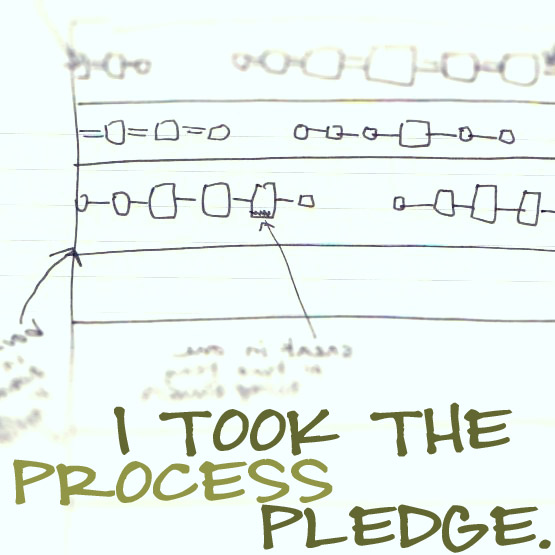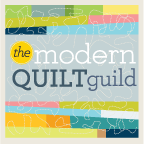It is worth taking a moment to discuss the fine points of fabric acquisition.
To gear up my stash for the Freddy Moran and Gwen Marston experience, I first turned to collecting black and white fabrics, something completely new to me. I was astonished at the variety available (having never noticed them before, **blush**), and at the effort fabric houses are putting into creating new and useful black and white prints. I quickly learned that these prints fall into three categories: prints that read primarily as black, prints that read primarily as white, and prints that read as grey. This last group, the busy and generally small scale black and whites that read as grey, are of limited use in the Marston/Moran style of quilting. In general, any fabric that is middle of the road in terms of contrast value, neither high nor low contrast value, adds to the "mush factor" in these quilts.
Many of us have experienced the mush factor via charm pack projects: if you construct a project out of charm packs in any one collection, the fabrics all fight for your eye time, and individual, lovely prints (no matter how prettily they match in terms of palette) get lost, utterly lost, in the visual confusion. The way to remedy this is to add high contrast sashing or rows, and this baby quilt pattern from the Moda Bakeshop site is a perfect example (below). The busy-ness of a charm pack has been pleasantly tamed by the visual rest-stop offered here by white fabric:
Marston and Moran use black and white to accomplish the same end, often sprinkling in "reads as black" or black fabric through the blocks themselves, and/or using black and white sawtooth or checkerboard strips to visually separate the more colour-full elements. Note that even in sawtooth or checkerboard construction, high contrast is a must for clean, sharp and sophisticated design. I quickly found that in making my first strips of sawtooth that the best look came from pairing one "reads as white" fabric with one "reads as black" fabric.
Also useful are fabrics which are some variation on black and white stripes: a big favourite of mine has been this wonderful irregular stripe: Micheal Miller "Ebony Reeds" CX-3529:
To gear up my stash for the Freddy Moran and Gwen Marston experience, I first turned to collecting black and white fabrics, something completely new to me. I was astonished at the variety available (having never noticed them before, **blush**), and at the effort fabric houses are putting into creating new and useful black and white prints. I quickly learned that these prints fall into three categories: prints that read primarily as black, prints that read primarily as white, and prints that read as grey. This last group, the busy and generally small scale black and whites that read as grey, are of limited use in the Marston/Moran style of quilting. In general, any fabric that is middle of the road in terms of contrast value, neither high nor low contrast value, adds to the "mush factor" in these quilts.
Many of us have experienced the mush factor via charm pack projects: if you construct a project out of charm packs in any one collection, the fabrics all fight for your eye time, and individual, lovely prints (no matter how prettily they match in terms of palette) get lost, utterly lost, in the visual confusion. The way to remedy this is to add high contrast sashing or rows, and this baby quilt pattern from the Moda Bakeshop site is a perfect example (below). The busy-ness of a charm pack has been pleasantly tamed by the visual rest-stop offered here by white fabric:
Marston and Moran use black and white to accomplish the same end, often sprinkling in "reads as black" or black fabric through the blocks themselves, and/or using black and white sawtooth or checkerboard strips to visually separate the more colour-full elements. Note that even in sawtooth or checkerboard construction, high contrast is a must for clean, sharp and sophisticated design. I quickly found that in making my first strips of sawtooth that the best look came from pairing one "reads as white" fabric with one "reads as black" fabric.
Also useful are fabrics which are some variation on black and white stripes: a big favourite of mine has been this wonderful irregular stripe: Micheal Miller "Ebony Reeds" CX-3529:
In terms of choosing coloured fabrics, Freddy advocates (wisely) the choice of highly saturated, pure colours, that is to say, colours that are not tinted with black or white. Designers like Brandon Mably and Jane Sassaman spring to mind here, but most bright collections (ie. Moda's "Happy") will contain some winning pure saturates.
The timing of my first visit to Back Porch coincided with the release of the Kaffe Fasset "Spots and Dots" line, and the fabric below revealed itself as one of my "super fabrics", a flexible mixer in clear colours that pleased my eye greatly:
And it turns out, bright polka dot fabrics in all scales will be a good addition to your Collaborative Quilting stash. Brightly coloured stripes, again in various scales, are also reliable stash bets. Both spots and stripes make fabulous binding fabrics.
When it comes to putting these brights together, keeping the contrasts dialed up is again the key to success. You want to include in your base fabrics high value and low value along with high hue balanced against black or black and white. In my mug rug photo, repeated below from an earlier blog post, you can see the contrast principle at work:
The centre black and white is small scale (and also dotted), and balances against the third row of larger scale, rectangular black and white stripes. The sapphire spot fabric is paired with a glowing cerise and orange stripe (so again, round with squares/rectangles, and hot colours paired against cool colours). Turquoise appears in many of the prints but is not dominant in any. The binding works not only in picking up that turquoise, but offering a dramatic hit of black. I stitched in the ditch (so as not to muddy the clear colours) with a variegated yellow and orange thread, which shows really nicely against the sapphire blue backing (the blue from Patrick Lose's "Mixmasters Dot to Dot" collection).
To begin with, I simply chose fabrics from my stash and laid them against each other on my cutting table. It quickly became clear which paired in a pleasing yet dramatic way.
Working in small projects like these mug rugs is a great way to experiment with colour and design without committing to a huge and expensive project. Liberated log cabin mug rug projects are especially well suited as a learning curve project in colour and design.
Past choosing small projects, I found that in tackling my class project, really my first "Freddy and Gwennie" project, using a strip quilt format worked well. I sewed parts into strips (ie. a strip of pinwheels, a strip of flying geese, a strip of 16 patches on point). Why? Because on the design wall, you can easily lay your strips side by side and start shoving them around into pleasing arrangements. It quickly became clear what background colour for my setting squares worked well, whether to add borders on all sides or just 1 or 2, what sawtooth and checkboard elements worked well between strips, etc.
Where did I get all these fabrics? I shopped brick and mortar when and where I could, faring well at Back Porch. But most of my local fabric stores are heavily traditional, and most in any case only stock a limited number of the new collections, and a limited selection from any one collection at that. Online vendors were a big help, and I could scan their offerings fairly quickly and comfortably, particularly when they allowed sorting the fabric images by colour. I find screen representations surprisingly accurate.
A good site to begin with is www.quiltshops.com, and from there I shop hard for free or no shipping. I like Desperate Quilters and Quilt Expressions in particular, not just for their selection and pricing, but the fact they tuck fun and useful little gifts (like note pads, pencils and pens) into my orders. Thanks, ladies!!
Other online shops I have used include FabricWorm, EQuilter, Fabric Shack, From Here to Quilternity, Hancock's of Paducah, Pink Chalk Fabrics, Sew Mama Sew. There are tons out there, you just have to track down the fabrics you are after, and using Google Images is a good way to turn up hard to find fabric sources. Incidentally, a good online fabric house will advise you if they are not able to fill your order precisely, and will give you the option of adding another fabric before placing your order. Since I often gauge my order to be maximum yardage for a shipping cost category, it can be a real extra cost to me when the fabric house ships me a short order. I track my shipping cost per fabric yard quite carefully.
Enough for today!
(to be continued...)













5 comments:
Thank you for this informative post. As a beginner quilter I sometimes feel completely overwhelmed by colour choices and safely buy a collection, but then feel frustrated that I'm not expressing myself. I find your observation about charm packs really helpful, thank you.
You are welcome! Because I don't have access to large, really well stocked fabric stores, I used charm packs to preview lines, then order the ones I think will work best for me in any given project. The charm pack then goes into the scrap basket (children love to plunder the scrap basket!). Charm packs are nicely tamed by putting them in projects with a well chosen solid.
Thank you for taking the time to write this. Very informative. I am taking a class from Gwen, at Asilomar next May. This is a great help. Carolyn Hughey
Thankyou! Asilomar is a wonderful venue, Carolyn. I have been there twice and love the fact that for 5 days you totally immerse yourself in the class work. I may be there in the same session in 2013, we are thinking of Sue Rasmussen. Freddie is also teaching a collage class at The Stitchin' Post in Sisters, OR. this year as well. If you like Gwen's liberated quilts, Jean Keenan Wells should also appeal.
This will be my second time at Asilomar. I took from Ruth McDowell, this year. I intend to go every year, from now on. Oddly, I, like you, have only been quilting 4 years. But, I took to it like a duck to water. Carolyn
Post a Comment